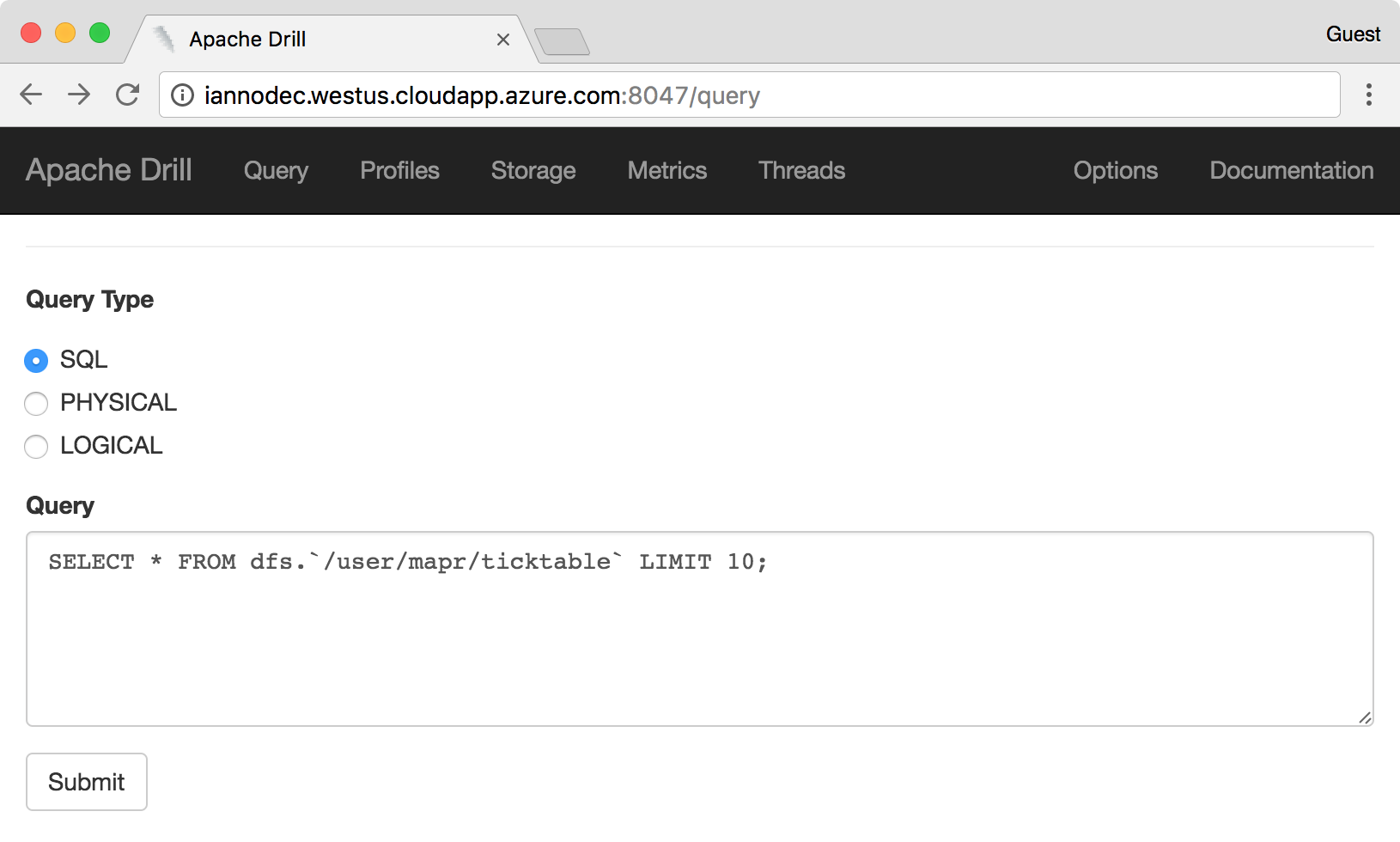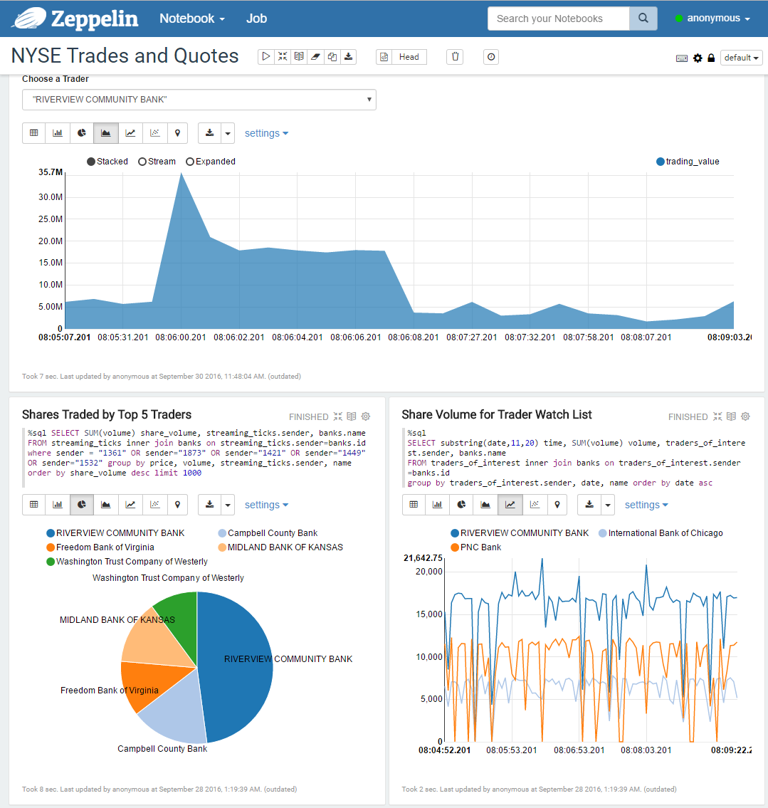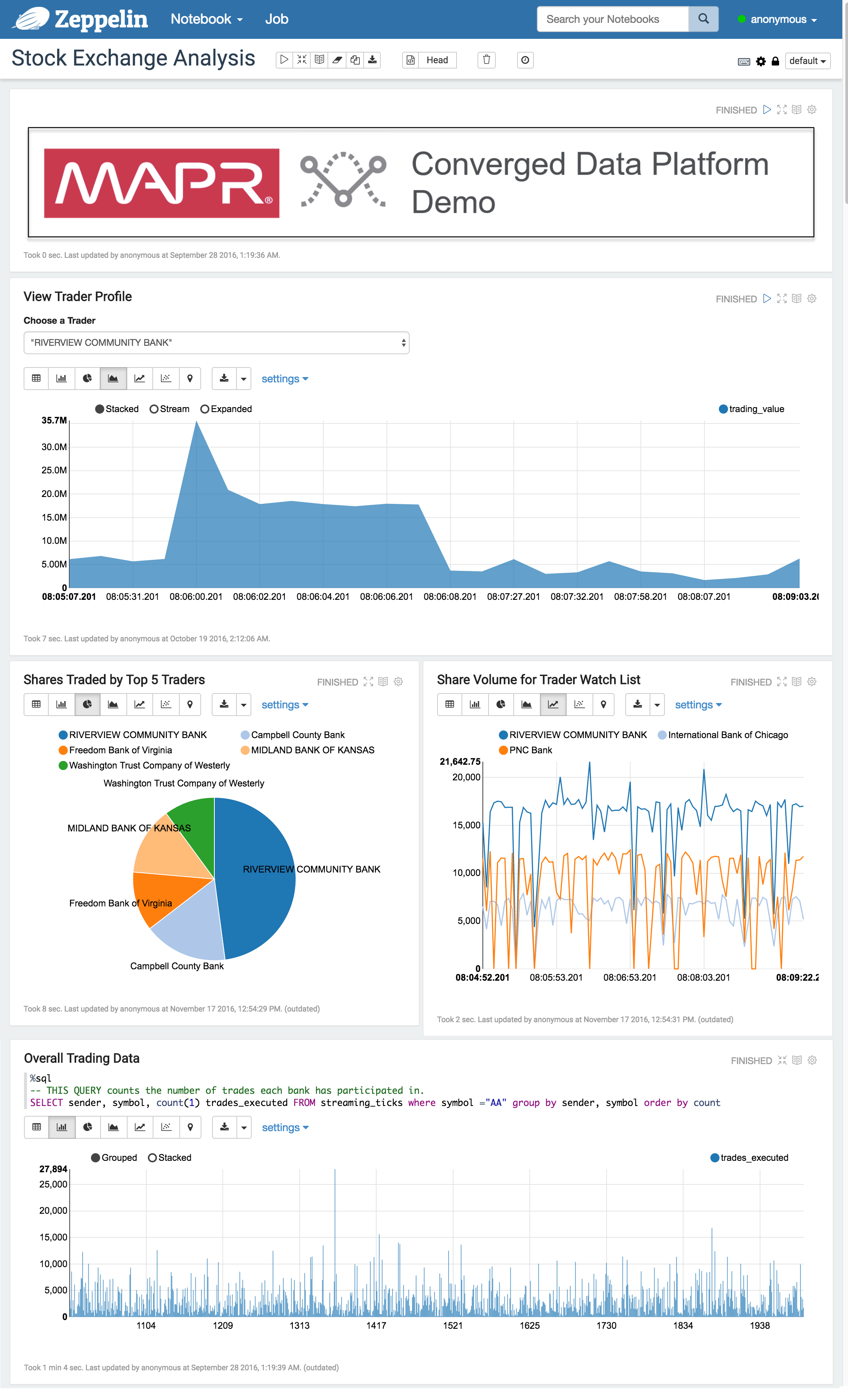BY USING THIS SOFTWARE, YOU EXPRESSLY ACCEPT AND AGREE TO THE TERMS OF THE AGREEMENT CONTAINED IN THIS GITHUB REPOSITORY. See the file EULA.md for details.
Stock exchanges offer real-time streams of information about the state of the market and trading activity. These data feeds channel a firehose of information that can be used to analyze market activity. However, these applications require a highly performant and reliable streaming infrastructure with accompanying services to process and store unbounded datasets. It can be challenging to build such infrastructures without incurring untenable operational expense and administrative burden.
This demo application focuses on interactive market analysis with a graphical user interface in Apache Zeppelin, however our goal is to use this application to tell a larger story about how the MapR Converged Data Platform can be used to cost effectively explore other stream processing use-cases, such as analyzing stock exchange data feeds for algorithmic trading or automated market surveillance.
The intent of the application is to serve as a "blueprint" for building high-speed streaming applications on the MapR Converged Data Platform. You can use the code as a base for developing your own workflow, including producers, consumers and analytical engines, and run queries against the indexed topics.
This project provides an engine for processing real time streams trading data from stock exchanges. The application consists of the following components:
- A Producer microservice that streams trades using the NYSE TAQ format. The data source is the Daily Trades dataset described here. The schema for our data is detailed in Table 6, "Daily Trades File Data Fields", on page 26 of Daily TAQ Client Specification (from December 1st, 2013).
- A multi-threaded Consumer microservice that indexes the trades by receiver and sender.
- Example Spark code for querying the indexed streams at interactive speeds, enabling Spark SQL queries.
- Example code for persisting the streaming data to MapR-DB
- Performance tests for benchmarking different configurations
- A supplementary python script to enhance the above TAQ dataset with "level 2" bid and ask data at a user-defined rate.
There are several beneficial aspects of the application that are worth highlighting:
- The Consumer microservice, performing the indexing, can be arbitrarily scaled simply by running more instances. See below in this README for how to start the application.
- Jackson annotations are provided for easy translation of the data structures to JSON and persistence to MapR-DB.
- The application can handle 300,000 entries/second on a 3-node cluster, which is suitable for testing. It does not require a large cluster, and takes advantage of the scaling properties of MapR Streams.
- The resulting index topics are small, and can be queried fast enough such that they can be used for interactive dashboards, such as in a Zeppelin notebook.
The application provides a financial intermediary service, running bids and asks between traders. Traders are identified with a unique ID and each bid and ask is sent from one trader to a set of N receiving traders.
The following diagram shows how data moves through the architecture. The rounded rectangles represent processes that produce and/or consume data from MapR Streams topics. Java based microservices are used to ingest and manipulate streaming data using the Kafka API. Spark and Apache Zeppelin are used to provide streaming analytics and batch oriented visualization.
This application requires MapR 5.2 and Spark 2.0, which can be easily installed with the MapR Ecosystem Pack 2.0. You can use MapR's free Converged Community Edition or the Converged Enterprise Edition.
You will also need Git and Apache Maven in order to download and compile the provided source code.
Clone this repo and build the application with Maven. A pom.xml file is included in the base directory. The remainder of this guide will assume that you clone the package to /home/mapr/.
cd /home/mapr/
git clone http://github.com/mapr-demos/finserv-application-blueprint.git
cd finserv-application-blueprint
mvn clean install
At this point you should see the resulting jar file in the target/ directory: nyse-taq-streaming-1.0.jar
Copy that jar package to the /home/mapr/ directory on each of your cluster nodes:
scp ./target/nyse-taq-streaming-1.0.jar mapr@<YOUR_MAPR_CLUSTER>:/home/mapr
A stream is a logical grouping of topics. They give us a way to group together topics and protect those topics with a single set of security permissions and other properties. MapR supports the Kafka API for interacting with streams. For more information on Streams, see https://www.mapr.com/products/mapr-streams.
Run the following command from any node in your MapR cluster:
maprcli stream create -path /user/mapr/taq -produceperm p -consumeperm p -topicperm p -ttl 900
In that command we created the topic with public permission since we want to be able to run producers and consumers from remote computers. Verify the stream was created with this command:
maprcli stream info -path /user/mapr/taq
We only need to create one topic to get started, the rest are created by the application. Topics are created with the maprcli tool. Run this command on a single node in the cluster:
maprcli stream topic create -path /user/mapr/taq -topic trades -partitions 3
Verify the topic was created successfully with this command:
maprcli stream topic list -path /user/mapr/taq
This enables 3 partitions in the topic for scaling across threads, more information on how partitions work can be found here.
We use a multi-threaded microservice that indexes the incoming information into separate topics by receiver and sender. We call this a "fan out" consumer, because it consumes tick data from incoming stock exchange stream and copies each tick record into topics belonging to all the participants of a trade. So for example, if this consumer sees an offer by Sender X to sell shares to recipients A, B, and C, then this consumer will copy that tick to four new topics, identified as sender_X, receiver_A, receiver_B, and receiver_C. This relationship is illustrated below:
A "tick" of this data consists of:
{time, sender, id, symbol, prices, ..., [recipient*]}
For each message in the stream there is a single sender and multiple possible receipients. The consumer will index these into separate topics so they can be queried.
Run the following command to start the consumer:
java -cp `mapr classpath`:/home/mapr/nyse-taq-streaming-1.0.jar:/home/mapr/finserv-application-blueprint/src/test/resources com.mapr.demo.finserv.Run consumer /user/mapr/taq:trades 3
In this example we are starting 3 threads to handle the 3 partitions in topic, /user/mapr/taq:trades.
Run the producer with the following command. This will send all the trades contained in files under finserv-application-blueprint/data/ to /user/mapr/taq:trades, where '/user/mapr/taq' is the stream and 'trades' is the topic.
java -cp `mapr classpath`:/home/mapr/nyse-taq-streaming-1.0.jar com.mapr.demo.finserv.Run producer /home/mapr/finserv-application-blueprint/data/080449 /user/mapr/taq:trades
A small data file representing one second of trades, bids and asks (data/080449) is provided for convenience. To generate more data, see the section 'Generating Data' below.
You should see the producer running and printing throughput numbers:
Throughput = 0.00 Kmsgs/sec published. Threads = 1. Total published = 2.
Throughput = 202.78 Kmsgs/sec published. Threads = 1. Total published = 411107.
Throughput = 377.08 Kmsgs/sec published. Threads = 1. Total published = 1139858.
Throughput = 463.34 Kmsgs/sec published. Threads = 1. Total published = 1865937.
Throughput = 478.99 Kmsgs/sec published. Threads = 1. Total published = 2406537.
This simulates "live" bids, asks and trades streaming from an exchange.
We'll explain two ways in which streaming data can be persisted into long-term storage. First we'll see how this can be done with MapR-DB, then we'll see how this can be done with Apache Hive.
The Persister.java class uses Spark SQL to persist JSON records from MapR Streams into MapR-DB.
This class can be run with the following command:
java -cp `mapr classpath`:/home/mapr/finserv-application-blueprint/target/nyse-taq-streaming-1.0.jar com.mapr.demo.finserv.Persister -topics /user/mapr/taq:sender_0310,/user/mapr/taq:sender_0410 -table /user/mapr/ticktable -droptable -verbose
This creates a stream consumer that persists trades from senders #0310 and #0410 to MapR-DB in a table located at /mapr/my.cluster.com/user/mapr/ticktable (which will be overwritten if it already exists, per the -droptable option). That command will only see new messages in the trades topic because it tails the log, so run the following command to put more trade data into the stream:
java -cp `mapr classpath`:/home/mapr/nyse-taq-streaming-1.0.jar:/home/mapr/finserv-application-blueprint/src/test/resources com.mapr.demo.finserv.Run consumer /user/mapr/taq:trades 3 &
java -cp `mapr classpath`:/home/mapr/nyse-taq-streaming-1.0.jar com.mapr.demo.finserv.Run producer /home/mapr/finserv-application-blueprint/data/ /user/mapr/taq:trades
Here are some examples of how you can query the table created by the Persister:
Query the MapR-DB table with dbshell:
mapr dbshell
maprdb mapr:> find /user/mapr/ticktable
Query the MapR-DB table from the Apache Drill command line:
/opt/mapr/drill/drill-*/bin/sqlline -u jdbc:drill:
0: jdbc:drill:> SELECT * FROM dfs.`/user/mapr/ticktable` LIMIT 10;
Query the MapR-DB table from the Apache Drill web interface, as shown below:
The SparkStreamingToHive class uses the Spark Streaming API to copy messages from the tail of streaming topics to Hive tables that can be analyzed in Zeppelin. Zeppelin can't directly access stream topics, so we use this utility to access streaming data from Zeppelin. Here's how to run this class:
/opt/mapr/spark/spark-2.0.1/bin/spark-submit --class com.mapr.demo.finserv.SparkStreamingToHive /home/mapr/nyse-taq-streaming-1.0-jar-with-dependencies.jar --topics <topic1>,<topic2>... --table <destination Hive table>
That command will only see new messages in the taq:trades topic because it tails the log, so when it says "Waiting for messages" then run the following command to put more trade data into the stream. This command was described in step 4:
java -cp `mapr classpath`:/home/mapr/nyse-taq-streaming-1.0.jar com.mapr.demo.finserv.Run producer /home/mapr/finserv-application-blueprint/data/ /user/mapr/taq:trades
In the previous command, we consumed from the trades topic, which is the raw stream for every trader. If you want to save only trades from a specific trader, then run the following command. This will read messages from the topic associated with the trader called sender_0410 and copy those messages to Hive. Remember, this tail operation so it will wait for new messages on that topic.
/opt/mapr/spark/spark-2.0.1/bin/spark-submit --class com.mapr.demo.finserv.SparkStreamingToHive /home/mapr/nyse-taq-streaming-1.0-jar-with-dependencies.jar --topics /user/mapr/taq:sender_0410 --table ticks_from_0410
There are many frameworks we could use to build an operational dashboard. Apache Zeppelin is a good choice because it supports a variety of ways to access data. Our goal is to build a dashboard that looks like this:
Here's what you need to do to setup a dashboard like that:
We're going to assume you've already installed Apache Zeppelin and configured its Spark SQL interpretter to access Hive tables. If you haven't done that, then follow the instructions for installing Zeppelin in this blog post:
https://community.mapr.com/docs/DOC-2029-how-to-use-spark-pyspark-with-zeppelin-on-mapr-cdp-draft
Import the bank company names into a new hive table. Later, we'll map these names to bank IDs with a table join in Zeppelin.
hive
hive> CREATE TABLE banks(id int, name string) ROW FORMAT DELIMITED FIELDS TERMINATED BY ',';
hive> LOAD DATA LOCAL INPATH '/home/mapr/finserv-application-blueprint/resources/bank_list.csv' INTO TABLE banks;
Run this command to load streaming data into a Hive table:
/opt/mapr/spark/spark-2.0.1/bin/spark-submit --class com.mapr.demo.finserv.SparkStreamingToHive /home/mapr/nyse-taq-streaming-1.0.jar --topics /user/mapr/taq:trades --table streaming_ticks
That command will only see new messages in the trades topic because it tails the log, so when it says "Waiting for messages" then run the following command to put more trade data into the stream:
java -cp `mapr classpath`:/home/mapr/nyse-taq-streaming-1.0.jar com.mapr.demo.finserv.Run producer /home/mapr/finserv-application-blueprint/data/ /user/mapr/taq:trades
Open Zeppelin in a web browser.
Zeppelin divides notebooks into subsections called paragraphs. Create a new notebook in Zeppelin, then in a new paragraph enter the following and press the 'Play' icon (or keyboard shortcut, Shift+Enter):
%sql show tables
You should see the banks and streaming_ticks tables in the list. If not, look for an error in the logs under /opt/zeppelin/logs/.
We've provided a sample Zeppelin notebook which includes some sample SQL queries and charts to get you started. Load the finserv-application-blueprint/resources/sample_zeppelin_notebook.json file with the Import feature in the Zeppelin web UI. After you've imported it, you should see a new notebook called "Stock Exchange Analysis" in Zeppelin, which looks like this:
You can download 500MB more trade data with the following commands. Note, these data files are kept in a separate GitHub repository in order to keep this one to a manageable size.
git clone https://github.com/mapr-demos/finserv-data-files
cd finserv-data-files
mkdir data
tar xvfz starter_datafiles.tar.gz -C data
You can then pass this data directory to the producer command described in step 4:
java -cp `mapr classpath`:/home/mapr/nyse-taq-streaming-1.0.jar com.mapr.demo.finserv.Run producer ./data/ /user/mapr/taq:trades
To save disk space, its a good idea to remove the stream and Hive tables that you created in prior steps.
Here's how to delete a stream and all the associated topics:
maprcli stream delete -path /user/mapr/taq
Here's how to delete a Hive table:
rm -rf /mapr/my.cluster.com/user/hive/warehouse/streaming_ticks/
Visit the MapR Community pages where you can post questions and discuss your use case.




